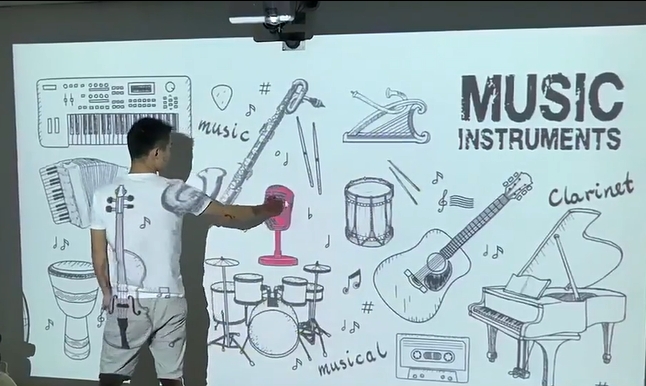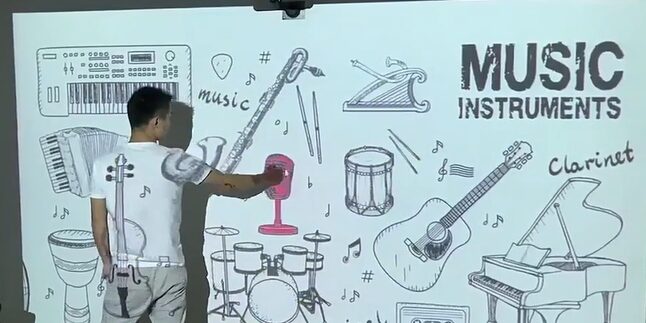Introduction
As interactive technology continues to evolve, traditional single-point touch systems are being replaced by multi-touch solutions, enabling simultaneous interactions from multiple users. LiDAR-powered interactive walls are at the forefront of this transformation, providing unparalleled precision, adaptability, and user engagement. This article explores how LiDAR enhances multi-touch interaction, its key advantages, and its practical applications.

What is a LiDAR Interactive Wall?
A LiDAR interactive wall is an advanced system that combines LiDAR sensors with projection technology to create immersive, touch-responsive surfaces. Unlike traditional touchscreens, these walls use laser-based detection to track user movements and gestures, allowing for a seamless and engaging experience across large-scale displays.
How Multi-Touch Works in LiDAR Interactive Walls
LiDAR interactive walls can detect multiple points of contact simultaneously, thanks to their high-resolution spatial tracking. Here’s how:
- Extensive Touch Coverage: A single LiDAR sensor typically covers up to 300 inches (approximately 600 cm x 300 cm). Larger installations can be achieved by integrating multiple sensors.
- High Precision: LiDAR technology can detect touch points with millimeter-level accuracy, ensuring smooth interaction without lag.
- Multi-User Engagement: Supports up to 256 simultaneous touch points, allowing multiple users to interact with the content simultaneously.
- Adaptive Surface Integration: Unlike traditional capacitive touchscreens, LiDAR interactive walls work on various surfaces, including walls, floors, and tables.

Key Benefits of Multi-Touch LiDAR Interactive Walls
1. Enhanced User Engagement
Multi-touch capabilities transform passive displays into dynamic, interactive experiences. Whether for educational exhibits or corporate presentations, users can interact with content in a more intuitive and immersive way.
2. Superior Real-Time Responsiveness
LiDAR sensors operate with low latency, capturing user inputs in real time. This ensures fluid interactions and enhances the user experience, even in fast-paced environments such as gaming or interactive storytelling.
3. Reliable Performance in Any Lighting Condition
Unlike optical-based touch solutions, LiDAR is unaffected by ambient lighting. Whether in dimly lit museum exhibits or bright conference halls, the system maintains accuracy and responsiveness.
4. Flexible and Scalable Installation
- Compact & Non-Intrusive: LiDAR sensors can be discreetly installed without obstructing the display area.
- Expandable: Multiple LiDAR units can be combined to create ultra-large interactive surfaces.
- Easy Calibration: Adjusting the touch area is straightforward, allowing for quick reconfiguration based on changing needs.
5. Minimal Maintenance & High Durability
LiDAR-based systems have fewer moving parts than traditional interactive setups, reducing wear and tear. This makes them ideal for high-traffic locations like museums, showrooms, and retail stores.
Real-World Applications
Exhibition & Museums
- Provide interactive storytelling experiences.
- Allow users to explore historical artifacts and scientific concepts through touch-enabled projections.
Corporate & Retail Showrooms
- Showcase products dynamically by letting customers interact with 3D models and detailed specifications.
- Enhance brand engagement with interactive advertisements and promotional displays.
Education & Training Centers
- Facilitate hands-on learning experiences with interactive lessons and simulations.
- Encourage group collaboration with shared interactive spaces.
Event & Entertainment Venues
- Create engaging digital art installations.
- Enable interactive gaming and immersive performances.
Future of LiDAR Multi-Touch Technology
With advancements in LiDAR accuracy and AI-driven interaction recognition, the future of interactive walls is set to become even more immersive. Enhanced gesture control, haptic feedback, and AI-powered content adaptation are expected to redefine user engagement.
Conclusion
LiDAR interactive walls revolutionize multi-touch technology, offering precise, immersive, and engaging experiences across various industries. Their ability to support multiple users, function in diverse environments, and integrate with different display surfaces makes them a game-changer in interactive technology.
Ready to Elevate Your Interactive Experience? CPJROBOT specializes in LiDAR solutions and reception robots, offering cutting-edge technology for immersive interactive displays. Contact us today to explore how LiDAR can transform your space!







